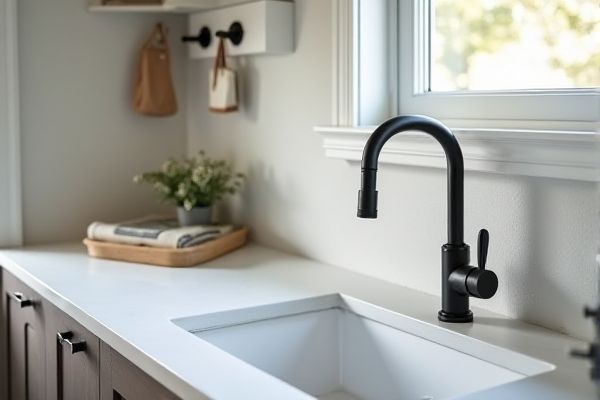
Touchless faucets in a mudroom offer enhanced hygiene by reducing contact with dirty hands, while manual faucets provide familiar control and potentially lower upfront costs. Explore the full article to determine which faucet best suits your mudroom needs and lifestyle.
Table of Comparison
| Feature | Touchless Faucet | Manual Faucet |
|---|---|---|
| Operation | Sensor-activated, hands-free | Manual handle or knob |
| Hygiene | Minimizes contact, reduces germs | Requires direct contact, higher germ transfer |
| Water Efficiency | Automatic shut-off, saves water | Dependent on user to turn off |
| Installation | Requires power source or batteries | Simple plumbing, no power needed |
| Maintenance | Sensor cleaning and battery replacement | Minimal, handle and valve upkeep |
| Cost | Higher upfront price | Lower initial cost |
| Durability | Sensor may be sensitive to damage | Typically robust and long-lasting |
| Ideal Use | High hygiene areas, mudrooms with frequent hands-free needs | Basic mudroom use, simple water access |
Introduction to Mudroom Faucet Choices
Mudroom faucet options include touchless and manual models, each offering distinct benefits for busy households. Touchless faucets provide hygienic, hands-free operation using infrared sensors, reducing the spread of germs and enhancing convenience when handling dirty tasks. Manual faucets deliver reliable, straightforward control over water flow and temperature, often at a lower cost and with simpler installation.
Touchless Faucet: How It Works
Touchless faucets in mudrooms use infrared sensors to detect hand movement, triggering water flow without physical contact. This sensor technology enhances hygiene by minimizing germ transmission and offers convenience for messy tasks. Compared to manual faucets, touchless models reduce water waste through precise activation and automatic shutoff.
Manual Faucet: Traditional Functionality
Manual faucets in mudrooms offer traditional functionality with precise control over water flow and temperature through physical handles. They require direct contact, making them reliable in environments where tactile feedback is preferred or in case of power outages affecting sensor-based models. Their straightforward design often results in durability and ease of maintenance compared to touchless faucets.
Hygiene Benefits in Mudrooms
Touchless faucets in mudrooms significantly reduce the spread of germs by eliminating the need to touch handles, which often carry dirt and bacteria from outdoor activities. Manual faucets require direct contact, increasing the risk of cross-contamination, especially in spaces where hands are frequently dirty. Installing a touchless faucet enhances your mudroom's hygiene by promoting cleaner, safer handwashing after outdoor exposure.
Water Efficiency Comparison
Touchless faucets in mudrooms typically reduce water waste by activating only when hands or objects are detected, minimizing unnecessary flow and dripping compared to manual faucets that can be left running inadvertently. Studies show touchless models can save up to 30% more water annually, enhancing overall water efficiency. Manual faucets rely on user vigilance, often leading to longer water usage durations and increased consumption.
Installation Requirements
Touchless faucets require an electrical power source, either batteries or a hardwired connection, alongside standard plumbing connections, making installation slightly more complex compared to manual faucets. Manual faucets involve straightforward plumbing without electrical components, typically requiring less time and fewer tools for installation. Proper sealing and alignment are essential for both types to prevent leaks and ensure optimal functionality in a mudroom setting.
Maintenance and Durability
Touchless faucets in mudrooms feature advanced sensor technology that reduces physical wear and tear, leading to lower maintenance needs and longer lifespan compared to manual faucets. Manual faucets rely on mechanical parts like handles and valves that require frequent cleaning and repairs due to constant use and exposure to dirt. High-quality touchless faucets from brands like Moen and Delta are designed with durable materials and self-cleaning sensors, enhancing both reliability and durability in busy mudroom environments.
Cost Considerations
Touchless faucets generally cost more upfront due to advanced sensor technology and require batteries or electrical power, increasing long-term maintenance expenses. Manual faucets offer lower initial prices and simpler installation, making them budget-friendly for mudroom use. Evaluating frequency of use and durability helps determine if higher investment in touchless models justifies overall cost savings.
Style and Design Options
Touchless faucets offer sleek, modern designs with smooth surfaces that complement contemporary mudroom aesthetics, minimizing touchpoints for a cleaner look. Manual faucets provide a wider variety of styles, from classic to rustic finishes, allowing you to match traditional decor and personal preferences more easily. Your choice depends on whether you prioritize cutting-edge style or versatile design options for your mudroom.
Which Faucet Is Best for Your Mudroom?
Touchless faucets in mudrooms offer enhanced hygiene and water efficiency by reducing contact and minimizing waste, making them ideal for busy, messy environments. Manual faucets provide reliable control and simplicity, often preferred where budget constraints and straightforward maintenance are priorities. Choosing the best faucet depends on balancing convenience, cleanliness, water savings, and installation costs specific to your mudroom's functionality.
 homyna.com
homyna.com